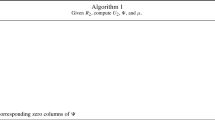Abstract
PARAFAC is a three mode factor analytic method developed by R.A. Harshman and is useful for data analysis. The fundamental idea says
where xijk is given by measurement for i=1, 2…,I, j=1, 2,…, J, k = 1, 2,…, K; aisbjs, and cks are unknown solutions for the s-th factor, s=1, 2,…, S. However the computer program of PARAFAC developed by Harshman seems to require great skill to understand how to handle it and select the optimal solution through many steps. Here a new fool-proof algorithm not to require any skill is presented.
Similar content being viewed by others
References
*Carroll, J.D. and Chang J.J. (1970). Analysis of Individual Differences in Multidimensional Scaling via an n-way Generalization of ‘Eckart-Young’ Decomposition, PsychometHka, 35, 283–319.
Harshman, R.A. (1970), Fonudations of the PARAFAC Procedure: Models and Conditions for an “Explanatory” Multi-Modal Factor Analysis, UCLA Working Papers in Phonetics, 16.
Harshman, R.A., Ladefoged, P. and Goldstein, L. (1977), Factor Analysis of Tongue Shapes, Journal of Acoust. Soc. Am., 62, 693–707.
Harshman, R.A. and Berenbaum, S.A. (1980), Basic Concepts Underlying the PARAFAC-CANDECOMP Three-Way Factor Analysis Model and its Application to Longitudinal Data, Present and Past in Middle Life, ed. Eichorn, D.H., Müssen, P.H., Clausen, J.A., Haan, N. and Honzik, M.P., Academic Press (New York).
*Hayashi, C. (1972). Two Dimensional Quantification Based on the Measure of Dissimilarity among Three Elements, Annals of the Inst, of Statist. Math., 24, 2, 251–257.
Hayashi, F, Yamaoka, K. and Terao, H. (1982) A Comparative Study between Two Algorithms of Parafac Model, in preparation for The Japanese Journal of Bihavirometrics.
* Kruskal, J.B. (1978), Factor Analysis and Principal Components: Bilinear Methods, International Encyclopedia of Statistics, ed. Kruskal, W. and Tanur, J., Macmillan and Free Press (New York), 307–330.
Kruskal, J.B. (1981). Multilinear Models for Data Analysis, Behaviormetrika, 10, 1–20.
Tucker, L.R. (1963). Implication of Factor Analysis of Three-Way Matrices for Measurement of Change, Problems in Measuring Change, ed. Harris, C.W., University of Wisconsin Press (Madison), 122–137.
*Tucker, L.R. (1964). The Extension of Factor Analysis to Three-Dimensional Matrices, Contributions to Mathematical Psychology, ed. Frederiksen, N., Holt, Rinehart and Winston (New York), 109–127.
*Tucker, L.R. (1966). Some Mathematical Notes on Three-Mode Factor Analysis, Psychometrika, 31, 279–311.
Author information
Authors and Affiliations
Additional information
This paper has been developed through discussions with J.B. Kruskal in Tokyo, 1980.
About this article
Cite this article
Hayashi, C., Hayashi, F. A New Algorithm to Solve Parafac-Model. Behaviormetrika 9, 49–60 (1982). https://doi.org/10.2333/bhmk.9.11_49
Received:
Published:
Issue Date:
DOI: https://doi.org/10.2333/bhmk.9.11_49




